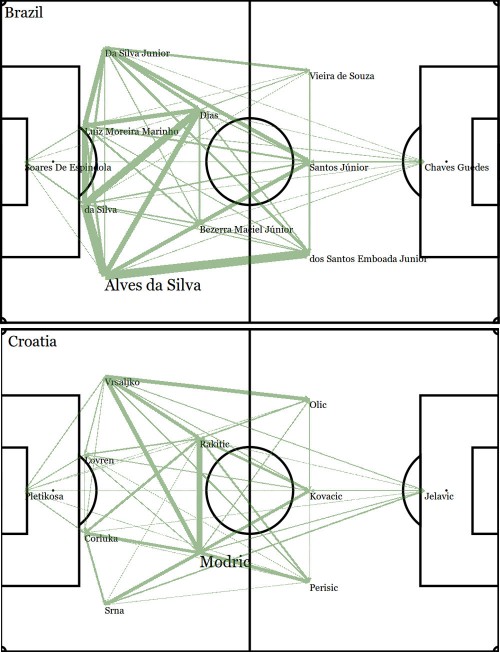By James Dacey
The FIFA World Cup is under way in Brazil as the national teams from 32 nations battle it out on the pitch for the most prestigious prize in football. It is also an exciting month for football fans across the world as everyone suddenly becomes an expert on the game. Offices, bars and cafes around the world echo with the sound of post-match analysis.
This post-match dissection has now been taken to another level by a pair of computer scientists at the University of Pisa in Italy. At the request of Physics World, Paolo Cintia and Luca Pappalardo have carried out a network analysis of the opening match of the tournament, which saw the hosts Brazil defeat Croatia by three goals to one. Cintia and Pappalardo have viewed the match as if it were an evolving network where players represent nodes that interact by passing the ball to each other along “edges”.
In the resulting image, the size of players’ name is proportional to the degree in the network, determined by the number of incoming and outgoing passes. The thickness of the edges between two given nodes is proportional to the number of passes between those two players during the time they were both on the pitch. So what did the researchers discover? At this point I’ll make an apology to non-football fans, because some of the next bit might mean absolutely nothing to you (thanks for getting this far anyway!).
Not that surprisingly, the most central player in the Croatian network was their midfield playmaker Luka Modrić. Perhaps more surprisingly, the most central player in the Brazilian network was their rightback Dani Alves (Alves da Silva), who is renowned for covering an awful lot of ground during games as he sprints up and down the right flank.
Taking their analysis to a higher level, Cintia and Pappalardo say that the network entropy of Brazil (the incertitude of the next pass) is higher than that of Croatia. In plain English what they are saying is that Brazil’s style of play was more diverse than that of Croatia; Brazil shared the ball among the team whereas Croatia tended to pass among the same players.
In the end of course, the only thing that matters to die-hard football fans is that their team wins the match. In this example, the more diverse team won but I’m sure there are plenty of other cases where the more predictable style won out. Likewise, being the most central player in a network does not necessarily translate to being the most influential – it’s what you do with the ball that counts. Still, there’s nothing wrong with bringing a bit of science to football analysis. It can’t be any less insightful than what the television pundits come out with!
Cintia and Pappalardo carried out the analysis at the Knowledge Discovery and Data Mining Laboratory (KDD LAB), a joint initiative of the University of Pisa and National Research Council of Italy (CNR).

Trackback: Physics Viewpoint | A network analysis of the FIFA World Cup
great job, but the brazilian players name are all wrong. I wouldn´t comment this but croatia´s players name are right.
dear friend
You are wrong!!!!!, Brazilian are shown with their last names that´s why you cannot recognized them
Can this be used to predict results of other matches. (Just curious, not a betting man)
In terms of passsing and repassing the balle amongst the players, so far the “game entropy” seemed to have the highest value for the Spanish team yet they have been been eliminated in the first round of the context!
Trackback: “Taca la bala” says the wizard: a trip into the World Cup 2014